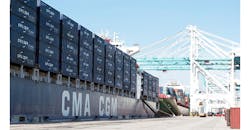NOAA system lets larger cargo ships safely enter PortMiami
Through use of the Physical Oceanographic Real-Time System (PORTS) offered by the National Oceanic and Atmospheric Administration (NOAA), super-size ships coming through the recently expanded Panama Canal can now more safely and efficiently enter the Miami FL seaport.
In addition to improved vessel safety, past NOAA studies have shown that a PORTS system, like the one dedicated by NOAA and PortMiami officials recently, can provide considerable economic benefit to the local community. Already one of the busiest ports in the world, Miami’s harbor supports over a hundred thousand jobs, while providing billions to the national economy.
“Through PORTS partnerships, seaports have the opportunity to increase the flow of cargo through their docks without the massive outlays normally associated with port expansion,” said US Secretary of Commerce Wilbur Ross. “Thanks to the hard work of NOAA staff and those in the private sector, Miami will not only have a safer harbor, but will also see even greater economic growth.”
PORTS is a public-private partnership that reduces ship accidents by more than 50%, increases the amount of cargo ships can carry, reduces transit delays for commercial traffic, enhances recreational activities, and improves hazardous spill response. Before the addition of PortMiami, a NOAA analysis estimated as much as a $300 million annual benefit from an expanded PORTS system. Including PortMiami, there are 31 PORTS in the United States, supporting 85% of the nation’s cargo by tonnage.
The PORTS model is in the same mold as the “transformative” proposals put forth in President Trump’s infrastructure initiative, in which federal assistance will be leveraged to spur local development. Trump’s proposal will return infrastructure decision-making to states and localities, allowing them to invest in the specific needs of their communities.
Representing a new opportunity for economic growth, larger cargo ships are transiting the Panama Canal each year, carrying millions of tons of goods. The New Panamax class is capable of holding twice the amount of cargo as those using the canal before it was widened.
The meters will provide ship operators with critical real-time information on currents that can help them better plan their transit and prevent accidents in and around the port. In Miami, strong currents from the Gulf Stream run perpendicular to the shipping channel. The current meters give vessel pilots the accurate, real-time data they need to make navigation decisions to direct the larger ships into port.
Access www.noaa.gov for more details.
